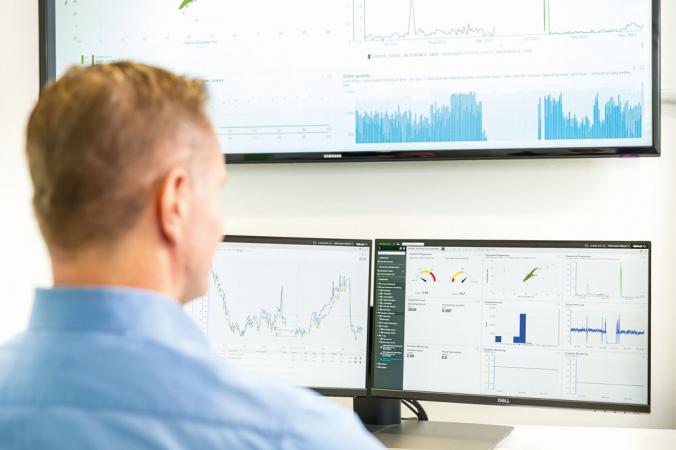Choosing the Right Diagnostic Tools
The human brain is amazing. How many times have you opened a drawer that’s full of all sorts of things and picked out the one thing that you opened the drawer to find?
We do this frequently and think little of it. How much more difficult would that search be if you did not know what the object that you wanted to find actually looked like?
Unfortunately, this happens a lot in the world of condition monitoring. Companies go to great lengths, and considerable expense, to purchase the “right” equipment or select the “right” contractor but then put almost no effort into the most important part of the preparation – to identify what failures look like. In the reliability world, this preparatory stage is called Failure Mode and Effect Analysis.
Having all the right tools and not knowing what to look for will yield minimal success – all that new high technology will end up on a shelf in a couple of years’ time and quite possibly there will be a stigma attached along the lines of “we tried that and it doesn’t work”.
Failure Mode and Effect Analysis (FMEA)
FMEA is like a formal, structured, version of Murphy’s Law.
- What system defects are possible?
- How likely are they?
- How significant are they?
- How can we design them out?
- How can we mitigate their effect on the system reliability?
- Is it cheaper and easier to run to failure?
- How can we identify their presence?
Condition monitoring is all about this last question, how to develop a structured measurement approach that goes looking for the onset of a particular failure mode. Included in this strategy is the realisation that not all failures are trendable – some failures, a leak is a good example, are binary. A leak exists or it doesn’t, it is binary. What would you be measuring on a pipe fitting that would predict that it is going to work loose?
My first manager in my professional career was an old Navy man who taught me that “to fail to prepare is to prepare to fail” and that is as true in the application of condition monitoring as anywhere else.
To correctly deploy a monitoring tool, first know what to look for and then choose how to find it. Choose? Yes, in many cases there are multiple tools that can find a problem. Realising that brings a refreshing freedom: if some of your team prefer to use one tool over another and both will find the problem, give your team the freedom to use whatever they enjoy using or are most comfortable using. The result? Inspection routines are completed, problems are found, your expensive tools are used and reliability increases.
What Can I Do with IR, Vib and US?
Infrared cameras measure Infrared radiation from which they compute temperature. IR cameras provide a full-field real-time display that allows the user to see thermal patterns and distributions far more quickly than can be achieved using a single point temperature device.
Vibration is a measurement of one of three things: acceleration (force), velocity (momentum or energy) or displacement depending upon the frequency range and the application. Phase measurement is a critical part of vibration measurement that is often overlooked. The use of phase allows a vibration instrument to perform balancing, operating deflection shape and modal testing.
Ultrasound instruments measure sound at frequencies beyond human hearing, for example in the frequency range between 36 and 40kHz. Ultrasound is particularly good at detecting three parameters: friction, impacting and turbulence. There are eight application pillars of this type of ultrasound equipment:
- Compressed gas leaks (air, CO2, Nitrogen, Argon, etc.)
- Steam leaks and steam traps
- Valves
- Hydraulics
- Electrical (LV, MV and HV)
- Tightness
- On-condition lubrication
- Rotating machinery condition
Clearly, from this list, ultrasound offers tremendous value for money in terms of problem coverage.
Crossover Applications
It is not uncommon to come across these crossover applications where multiple tools are available but a purist will insist that “this is the right way to find this problem”. Right way? There is no right way. If there is a problem and it can be found, surely that is the primary concern, not compliance with some unwritten norm that says “thou shalt use …… to find this problem”.
Coupling misalignment is a typical example of a crossover application. It is possible to take vibration measurements to deduce that there is coupling misalignment. If there is line of sight of the coupling (something which is quite rare these days) it is possible to identify that the coupling is warming up, which is going to be caused by the periodic friction generated by the misalignment. Friction? Ultrasound can hear friction. So by simply placing an airborne flexible sensor close to a gap in a coupling guard, the technician can hear and record the periodic friction associated with coupling misalignment.
One highly topical example of a crossover application is bearing lubrication. Industry around the world is realising that there is a problem here. Major bearing manufacturers tell us that between 50 and 80 percent of all premature bearing failures are cause by lubrication issues.
If the manufacturers are correct, what is the point of taking vibration readings that are not focussed on finding lubrication issues? Few, definitely not all, vibration practitioners have additional training in lubrication. Those that do recognise that the higher frequency measurements associated with ultrasound provide greater sensitivity to the frictional condition.
A bearing that needs grease will warm up, so why not use an IR camera? This is partially true, but if the environment that the bearing is operating in is already hot, it is unlikely that under-lubrication is going to cause a further elevation in the temperature. Furthermore, lubrication physics tells us that under-lubrication and over-lubrication will both increase friction and therefore temperature. This will make the use of an IR camera difficult.
Finally, there may be other defects present – consider a fan bearing next to a misaligned pulley. Our IR training tells us that the misalignment will warm up the pulley. Thermodynamics tells us that the heat from the warm pulley will conduct down the shaft and warm up the pulley bearing. Oh! I have a hot bearing, I must grease it. Is it possible to lubricate away pulley misalignment?
FMEA is suggesting that the course of action is to design out this problem. The problem springs from the reality that all bearings do not consume grease at the same rate, which means that their need for replenishment is different. Accepting this reality means that greasing large groups of bearings in the same way on a time basis is not logical.
One of the key approaches which is being used around the world for this major problem is on-condition lubrication using ultrasound. In Graph 1 we can see a lubrication history using ultrasound:
This is a route-based approach. The lubrication technician follows a pre-defined path through a group of bearings. For each bearing there is a history of readings. If the current reading exceeds an alarm condition, the technician
- stores the “before” reading,
- makes a comment to flag that the bearing was greased,
- performs an ultrasonic lubrication
- records a second “after” reading
The result is a history for every bearing in the database. When it was greased and what condition it was left in.
Using ultrasound during the lubrication process means that the difference between a bearing that needed grease (reduction in ultrasound) is clearly different from a bearing that was already over-greased (increase in ultrasound).
Using ultrasound for lubrication in this way has produced some incredible successes. One mining Company reported a staggering reduction in grease consumption from 22 drums (15Kg each) per month to just 1 drum per month with a significant increase in machine reliability. A water treatment plant reported at the end of 2015 that since the implementation of their ultrasound programme, they had not had an unexpected motor bearing failure in three years.
Summary
There are many condition monitoring tools at your disposal. Ensure that you perform a thorough FMEA in order to uncover those defects that are most likely to hurt you and develop your condition monitoring strategies to deal with those problems in the most convenient way for your engineering talents.
FMEAs frequently fail because the output is corrupted to
- What tools do we have?
- What modes will we list then?
Instead of reaching the conclusions of:
- What needs to be measured?
- Do we have the tools to find these modes?
Your future success depends upon choosing the right tools.








![EMR_AMS-Asset-Monitor-banner_300x600_MW[62]OCT EMR_AMS-Asset-Monitor-banner_300x600_MW[62]OCT](/var/ezwebin_site/storage/images/media/images/emr_ams-asset-monitor-banner_300x600_mw-62-oct/79406-1-eng-GB/EMR_AMS-Asset-Monitor-banner_300x600_MW-62-OCT.png)



